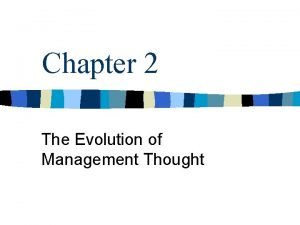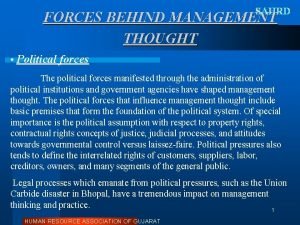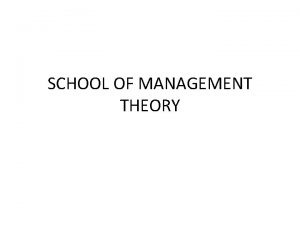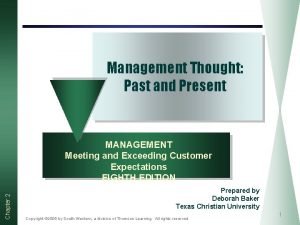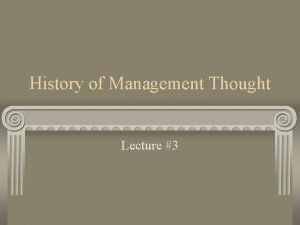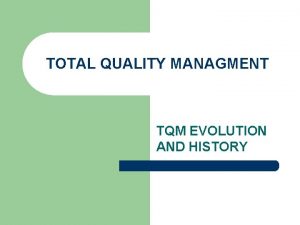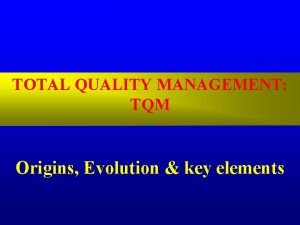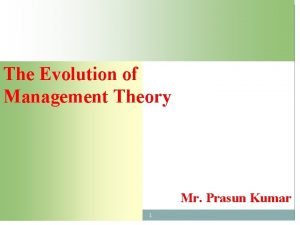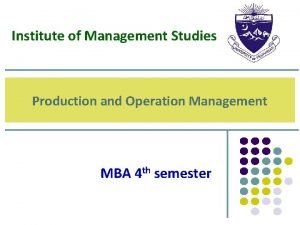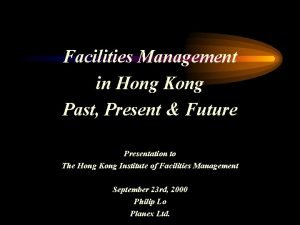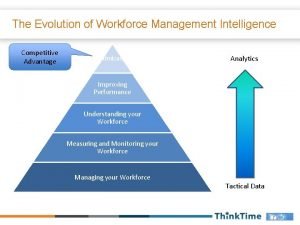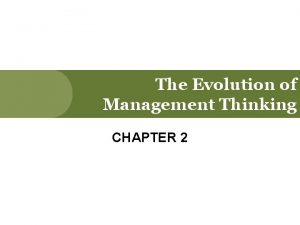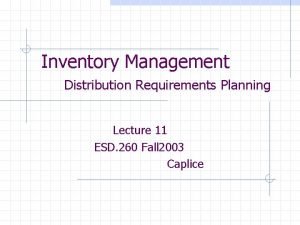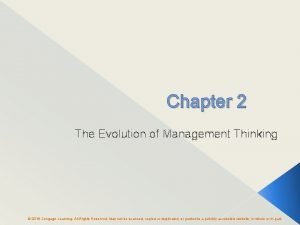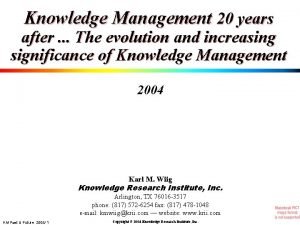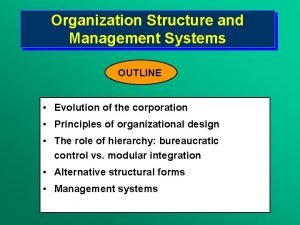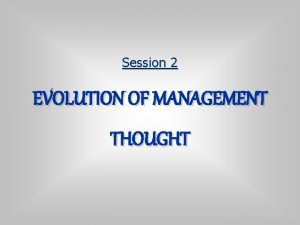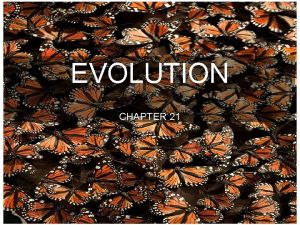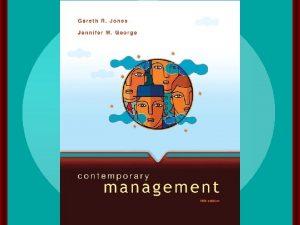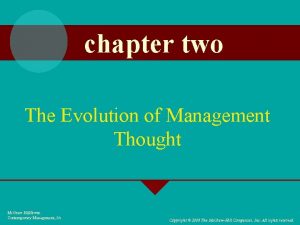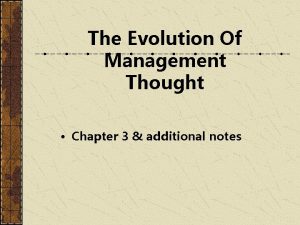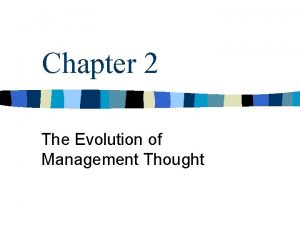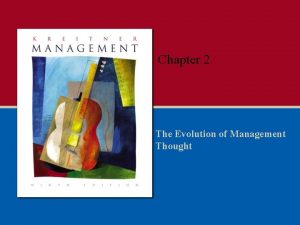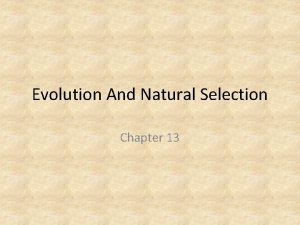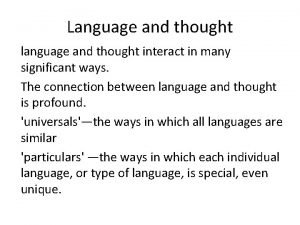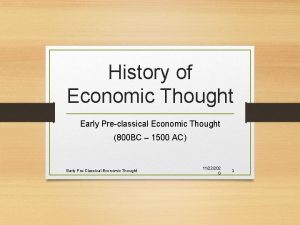Chapter 2 The Evolution of Management Thought The



















- Slides: 19

Chapter 2 The Evolution of Management Thought

The Evolution of Management Theory MGMT 321 – Chapter 2

Job Specialization and the Division of Labor n Adam Smith – 2 different ways to manufacture pins – Craft-style: each worker did all steps – Production: each worker specialized in one step n Job Specialization – Different workers specialize in specific tasks over time MGMT 321 – Chapter 2

F. W. Taylor and Scientific Management n Systematic study of the relationships between people and tasks to redesign the work process to increase efficiency n Consists of 4 principles – Study tasks to identify improvements – Create written rules and SOPs – Select and train workers carefully – Establish fair performance standards and reward accordingly MGMT 321 – Chapter 2

Problems with Scientific Management n Managers frequently implemented only the increased output side of Taylor’s plan – Workers did not share in the increased output n Specialized jobs became very boring, dull – n Workers ended up distrusting the Scientific Management method Workers could purposely “under-perform” – Management responded with increased use of machines and conveyors belts MGMT 321 – Chapter 2

The Gilbreths Break up and analyze each action of a task into its component actions 2. Find better ways to perform each component action 3. Reorganize the component actions to be more efficient, at less cost in time and effort 1. MGMT 321 – Chapter 2

Administrative Management Theory n Study of how organizational structure affects efficiency and effectiveness n Max Weber – Developed the principles of bureaucracy as a formal system designed to ensure efficiency and effectiveness MGMT 321 – Chapter 2

Weber’s Principles of Bureaucracy MGMT 321 – Chapter 2

Fayol’s Principles of Management n Division of Labor – Jobs can have too much specialization leading to poor quality and worker dissatisfaction n Authority and Responsibility – Both formal and informal authority n Unity of Command – Employees should have only one boss n Line of Authority – A clear chain of command from top to bottom MGMT 321 – Chapter 2

Fayol’s Principles of Management n Centralization – The degree to which authority rests at the top n Unity of Direction – A single plan of action to guide the organization n Equity – The justice and fairness in the treatment of all employees n Order – Arranging employees to be of the most value and to provide career opportunities MGMT 321 – Chapter 2

Fayol’s Principles of Management n Initiative – Fostering creativity and innovation by encouraging employees to act on their own n Discipline – Obedient, applied, respectful employees are necessary for the organization to function n Remuneration of Personnel – An equitable uniform payment system that motivates contributes to organizational success MGMT 321 – Chapter 2

Fayol’s Principles of Management n Stability of Tenure of Personnel – Long-term employment develops skills that improve organizational performance n Subordination of Individual Interest – The interest of the organization takes precedence n Esprit de corps – Foster comradeship, shared enthusiasm, and devotion to the common cause MGMT 321 – Chapter 2

Behavioral Management Theory n The study of how managers should behave to: – Motivate employees – Encourage them to perform at high levels – Be committed to the achievement of organizational goals n Mary Parker Follett – Concerned that Taylor ignored the human side of the organization MGMT 321 – Chapter 2

The Hawthorne Studies n How work setting characteristics affect fatigue and performance – Regardless of whether the light levels were raised or lowered, worker productivity increased – Hawthorne effect – workers’ attitudes toward their managers affect performance – Implications – behavior of managers and workers is as important in explaining the level of performance as the technical aspects of the task MGMT 321 – Chapter 2

Douglas Mc. Gregor’s Theory X and Y MGMT 321 – Chapter 2

Management Science Theory n Utilizes quantitative techniques to help managers maximize the use of organizational resources – Quantitative management – Operations management – Total Quality Management (TQM) – Management Information Systems (MIS) MGMT 321 – Chapter 2

Organizational Environment Theory n The set of forces and conditions that operate beyond an organization’s boundaries but affect a manager’s ability to acquire and utilize resources MGMT 321 – Chapter 2

The Open-Systems View MGMT 321 – Chapter 2

Contingency Theory MGMT 321 – Chapter 2
 Evolution of management thoughts
Evolution of management thoughts An incomplete thought
An incomplete thought Sahrd
Sahrd School of management theory
School of management theory Quantitative school of management thought
Quantitative school of management thought History of management thought
History of management thought Taylor shovel experiment
Taylor shovel experiment Chapter 10 memory and thought answers
Chapter 10 memory and thought answers History of quality management evolution
History of quality management evolution Inventor of quality management
Inventor of quality management Evolution of management theory
Evolution of management theory Historical evolution of operations management
Historical evolution of operations management Facility management history and evolution
Facility management history and evolution The evolution of workforce management
The evolution of workforce management Management thinking adalah
Management thinking adalah Evolution of inventory management
Evolution of inventory management Evolution of quality management system
Evolution of quality management system Evolution of management thinking
Evolution of management thinking Evolution of knowledge management
Evolution of knowledge management Evolution of management systems
Evolution of management systems
